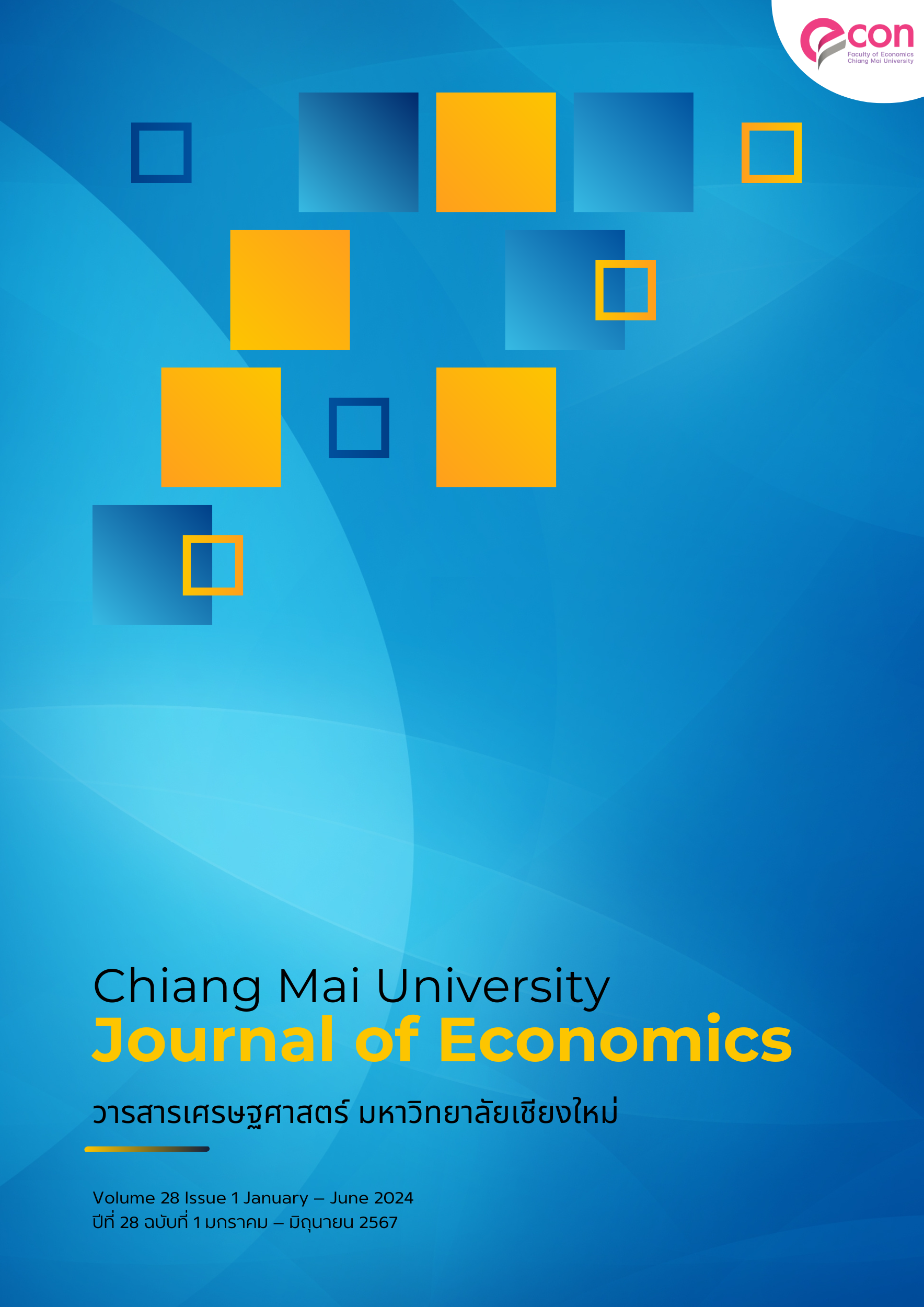The impact of the BTS Skytrain services on the Gross Provincial Products in Bangkok's tourism industry
Keywords:
Gross Provincial Products of Bangkok, Tourism industry, the amount of BTS passengers, BTS stock priceAbstract
This study aimed to measure the impact of BTS Skytrain services on Gross Provincial Products
(GPP) in Bangkok’s tourism industry. This study used secondary data from 2001–2023. The
dependent variable was the GPP in Bangkok’s tourism industry, especially in the accommodation
and food service sectors. It was hypothesized that the number of workers in Bangkok's
accommodation and food service sectors, the amount of capital stock in Bangkok's accommodation
and food service sectors, and the number of tourists using the BTS service would impact the tourism
industry in Bangkok. The impact was estimated by the ordinary least squares (OLS) method.
The study found that the amount of capital stock and the number of tourists using the BTS service
were major factors in raising the GPP in Bangkok’s tourism industry at a 95% significant level. It
implies that in expanding the growth of Bangkok's tourism industry, Policymakers should be aware
of the importance of two factors. The first factor is the amount of capital stock, that is, they should
focus on increasing capital in Bangkok's tourism industry. The second factor is that the BTS Skytrain
should be able to accommodate a large number of passengers, including tourists.
References
กองยุทธศาสตร์บริหารจัดการ ส านักยุทธศาสตร์และประเมินผล กรุงเทพมหานคร. (ม.ป.ป.). สถิติกรุงเทพมหานคร.
https://webportal.bangkok.go.th/
จิรวัฒน์ เจริญสถาพรกุล. (2551). แรงขบเคลอนของการวจยตออตราการเจรญเตบโตภาคเกษตรไทย.วารสาร
เศรษฐศาสตร์ศรีนครินทรวิโรฒ, 4, 82-92.
นิกร น้อยพรม, และณรงค์ กมลชิต. (2559). ภาคบรการการทองเทยวแรงขบเคลอนใหมของเศรษฐกจ จังหวัดเลย.
วารสารวิจัยและพัฒนา มหาวิทยาลัยราชภัฏเลย, 11(36), 1-11.
บรษท ระบบขนสงมวลชนกรงเทพ จากด (มหาชน). (ม.ป.ป.). ประวัติความเป็นมา. BTS.
https://www.bts.co.th/info/info-history.html
ประมวล สุธีจารุวัฒน, สมพงษ์ ศิริโสภณศิลป์ , ธารทัศน์ โมกขมรรคกุล, สุภารัตน์ ตันทนงศักดิ ์กุล, วันชัย มีชาติ, และ
วิษารัช สัญญาลักษณ์ฤาชัย. (2554). แนวทางการพฒนาอตสาหกรรมรถไฟฟาขนสงมวลชน และ
อตสาหกรรมเกยวเนองประเทศไทย. วารสารการขนส่งและโลจิสติกส์, 3(1), 41-56.
ลีชัย ปัญญาวงศ์งาม. (2552). ปจจยทมอทธพลตออตสาหกรรมทองเทยวในกรงเทพมหานคร. วารสารมหาวิทยาลัย
นเรศวร,19(2), 64-71.
วินัสยา สุริยาธานินทร. (28 เมษายน 2558). บทวิเคราะห์ทางเศรษฐกิจเรื่อง ภาคบริการ แรงขับเคลื่อนใหม่ของระบบ
เศรษฐกิจไทย. ธนาคารแหงประเทศไทย.
https://www.bot.or.th/Thai/ResearchAndPublications/DocLib_/article28_04_58.pdf
ศุภลัคน์ ศิริบูรณานนท์, และ รัตติยากร ลิมัณตชัย. (26 เมษายน 2559). บทวิเคราะห์ทางเศรษฐกิจเรื่องภาคบริการ จะ
เป็นพลังขับเคลื่อนเศรษฐกิจไทยอย่างยั่งยืนได้อย่างไร. ธนาคารแหงประเทศไทย.
https://www.bot.or.th/Thai/ResearchAndPublications/DocLib_/Article27_04_59.pdf
สานกงานปลดกระทรวงการทองเทยวและกฬา. (2566). สถิติด้านการท่องเที่ยว. ส านักงานปลัดกระทรวงการ
ทองเทยวและกฬา. https://www.mots.go.th/news/category/704
ส านกงานสถตแหงชาต. (2562). ส ารวจภาวการณ์ท างานของประชากร. ส านกงานสถตแหงชาต.
สานกงานสภาพฒนาการเศรษฐกจและสงคมแหงชาต. (2566). ภาวะเศรษฐกิจไทยไตรมาสที่สี่ของปี 2566 ทั้งปี 2566
และแนวโน้ม ปี 2567. สานกงานสภาพฒนาการเศรษฐกจและสงคมแหงชาต.
https://www.nesdc.go.th/ewt_dl_link.php?nid=14743&filename=QGDP_report
Chen, Z., & Haynes, K. E. (2015). Tourism industry and high-speed rail, is there a linkage: Evidence from China’s high-speed rail
development. Transport Policy, 45, 255-266.
Delaplace, M., Perrin, J., & Bazin, S. (2015). High-Speed Rail, Tourism and Territories: A Multi-Dimensional Approach.
European Planning Studies, 23(3), 556-574.
Givoni, M., & Banister, D. (2012). The Ambivalent Role of High-Speed Rail in Europe. In High-Speed Rail and Sustainability (pp.
-29). Routledge.
Pagliara, F., La Pietra, A., & Vassallo, J. M. (2015). High-Speed Rail and Tourism: Evidence from the Madrid-Barcelona Corridor.
Journal of Transport Geography, 47, 131-137.
Downloads
Published
Issue
Section
License
Copyright (c) 2024 CHIANG MAI UNIVERSITY JOURNAL OF ECONOMICS

This work is licensed under a Creative Commons Attribution-NonCommercial-NoDerivatives 4.0 International License.
All opinions and contents in the CMJE are the responsibility of the author(s). Chiang Mai University Journal of Economics reserves the copyright for all published materials. Papers may not be reproduced in any form without the written permission from Chiang Mai University Journal of Economics.
ข้อคิดเห็นที่ปรากฏและแสดงในเนื้อหาบทความต่างๆในวารสารเศรษฐศาสตร์มหาวิทยาลัยเชียงใหม่ ถือเป็นความเห็นและความรับผิดชอบโดยตรงของผู้เขียนบทความนั้นๆ มิใช่เป็นความเห็นและความรับผิดชอบใดๆของวารสารเศรษฐศาสตร์ มหาวิทยาลัยเชียงใหม่
บทความ เนื้อหา และข้อมูล ฯลฯ ในวารสารเศรษฐศาสตร์มหาวิทยาลัยเชียงใหม่ ถือเป็นลิขสิทธิ์เฉพาะของคณะเศรษฐศาสตร์มหาวิทยาลัยเชียงใหม่ หากบุคคลหรือหน่วยงานใดต้องการนำทั้งหมดหรือส่วนหนึ่งส่วนใดไปเผยแพร่ต่อหรือเพื่อกระทำการใดๆ จะต้องได้รับอนุญาตเป็นลายลักษณ์อักษร จากวารสารเศรษฐศาสตร์ มหาวิทยาลัยเชียงใหม่






